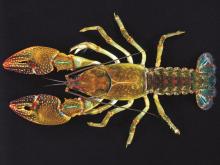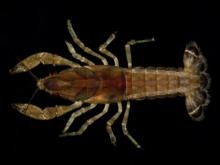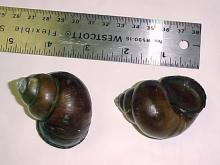Aquatic Invertebrates
Media

Species Types
Scientific Name
Lacunicambarus ludovicianus (syn. Cambarus ludovicianus)
Description
The painted devil crayfish is a burrowing lowland species. In Missouri, it is known from only a few locations in the Bootheel. Its overall color is olive green to blue, with reddish and cream markings.
Media

Species Types
Scientific Name
Lacunicambarus polychromatus (syn. Cambarus polychromatus)
Description
The paintedhand mudbug is a burrowing crayfish known in Missouri from only a few locations along the eastern border of the Bootheel. It is tan to olive green, and the abdominal segments and tail fan are trimmed with red. The pincers have red spots and red tips.
Media

Species Types
Scientific Name
Lacunicambarus aff. diogenes (syn. Cambarus diogenes)
Description
The powerfully built devil crayfish is usually a uniform olive or tan, without obvious blotches or spots. It digs underground burrows, often with mud chimneys, and has a wide distribution.
Media

Species Types
Scientific Name
Faxonella clypeata
Description
The shield crayfish is small and tan, with a pattern of paired blackish dashes along the surface of the carapace and abdomen. The pincers are narrow, with short, abruptly tapering fingers. In Missouri it occurs only in our southeast counties.
Media

Species Types
Scientific Name
Faxonius immunis (formerly Orconectes immunis)
Description
The calico crayfish is rather plain: gray-green with a pale central zone along the middle of the carapace and abdomen. The pincers are orange-tipped, and in mature males are tinged with purple. It is usually only found in the northern half of the state.
Media

Species Types
Scientific Name
Toxolasma parvus
Description
These diminutive mollusks are the smallest of Missouri’s freshwater mussels.
Media

Species Types
Scientific Name
Bivalve molluscs in order Unionoida
Description
Secretive and seldom seen, freshwater mussels are extraordinarily diverse in Missouri. We have nearly 70 species within our borders. Many are declining, and several are endangered.
Media

Species Types
Scientific Name
Gyraulus, Helisoma, Menetus, Micromenetus, Planorbula spp.
Description
Ramshorn snails are easy to identify at a glance, because the shell is a flat, disklike coil. Like other pulmonate aquatic snails, they lack the hard horny “trapdoor” possessed by other types of aquatic snails.
Media

Species Types
Scientific Name
Cipangopaludina chinensis malleata (syn. Bellamya chinensis)
Description
The Chinese mysterysnail is a nonnative invasive species quickly taking over urban waters throughout the state. Never release aquarium species or aquarium water into natural aquatic habitats. Learn about and practice clean boating techniques so that you do not accidentally spread invasive aquatic species.
Species Types
Scientific Name
Various species in the genus Hydra
Description
We’ve all seen aquariums and pictures of tropical saltwater invertebrates such as corals, jellyfish and anemones—but did you know that there are similar creatures living in the freshwater habitats of Missouri?
See Also
About Aquatic Invertebrates in Missouri
Missouri's streams, lakes, and other aquatic habitats hold thousands of kinds of invertebrates — worms, freshwater mussels, snails, crayfish, insects, and other animals without backbones. These creatures are vital links in the aquatic food chain, and their presence and numbers tell us a lot about water quality.





















